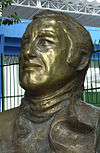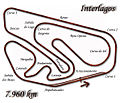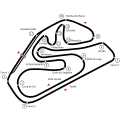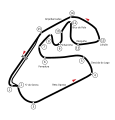Interlagos Circuit
hideThis article has multiple issues. Please help or discuss these issues on the talk page. (Learn how and when to remove these template messages)
|
 | |
| Location | São Paulo, Brazil |
|---|---|
| Time zone | UTC−03:00 |
| Coordinates | 23°42′4″S 46°41′50″W / 23.70111°S 46.69722°WCoordinates: 23°42′4″S 46°41′50″W / 23.70111°S 46.69722°W |
| Capacity | 60,000 |
| FIA Grade | 1 |
| Broke ground | 1938 |
| Opened | 1940 |
| Former names | Autódromo de Interlagos (1940–1985) |
| Major events | Formula One Brazilian Grand Prix (1972–1977, 1979–1980 and 1990–2019) São Paulo Grand Prix (2021–) FIA World Endurance Championship 6 Hours of São Paulo (2012–2014) Mil Milhas Brasil, Stock Car Brasil, Fórmula Truck, TC 2000, Formula 3 Sudamericana (until 2013), Brazilian Formula Three Championship (2014–present) |
| Current circuit (2000–present) | |
| Length | 4.309 km (2.677 mi) |
| Turns | 15 |
| Race lap record | 1:10.540 ( |
| 4th variant (1997–1999) | |
| Length | 4.292 km (2.667 mi) |
| Turns | 15 |
| Race lap record | 1:18.397 ( |
| 3rd variant (1990–1996) | |
| Length | 4.325 km (2.687 mi) |
| Turns | 15 |
| Race lap record | 1:18.455 ( |
| 2nd variant (1979–1989) | |
| Length | 7.873 km (4.893 mi) |
| Turns | 26 |
| Race lap record | 2:27.31 ( |
| Original circuit (1940–1978) | |
| Length | 7.960 km (4.946 mi) |
| Turns | 26 |
| Race lap record | 2:34.16 ( |
| Website | www |
The Autódromo José Carlos Pace, better known as Interlagos, is a motorsport circuit located in the city of São Paulo, in the neighborhood of Interlagos. It was renamed after Brazilian Formula One driver Carlos Pace, who died in a plane crash in 1977. It has hosted the Formula One Brazilian Grand Prix since 1973.
History[]

The land on which the circuit is located was originally bought in 1926 by property developers who wanted to build housing.[1] Following difficulties partly due to the 1929 stock market crash, it was decided to build a racing circuit instead, construction started in 1938 and the track was inaugurated in May 1940.[1] The design was based on New York's Roosevelt Field Raceway (1937 layout).[2]
The traditional name of the circuit (literally, "between lakes") comes from its location on the neighborhood of Interlagos, a region between two large artificial lakes, Guarapiranga and Billings, which were built in the early 20th century to supply the city with water and electric power. It was renamed in 1985 from "Autódromo de Interlagos" to its current name to honor the Brazilian Formula One driver José Carlos Pace, who died in a plane crash in 1977.[3]
Formula One started racing there in 1972, the first year being a non-championship race, won by Argentinean Carlos Reutemann. The first World Championship Brazilian Grand Prix was held at Interlagos in 1973, the race won by defending Formula One World Champion and São Paulo local Emerson Fittipaldi. Fittipaldi won the race again the following year in bad weather and Brazilian driver José Carlos Pace won his only race at Interlagos in 1975.
Due to safety concerns with the 4.9 mile circuit, including the bumpy track surface and the inadequate barriers, deep ditches, and embankments, the last Formula One race held on the original Interlagos was in 1980, the race was nearly cancelled after protests by many Formula One drivers including defending world champion Jody Scheckter. The safety concerns were somewhat directed towards the track surface, which BBC commentator Murray Walker described as "appallingly bumpy". Most of the ground-effect cars of 1980 were designed in such a way that bumpy surfaces were barely tolerable for the drivers. These factors meant that Formula One would move back to the Jacarepaguá circuit in Rio de Janeiro, hometown of established star Nelson Piquet and where the Brazilian Grand Prix was held in 1978. After Formula One moved away, the only major race being held at Interlagos was the Mil Milhas Brasil, and the last major race on the original circuit was the 1989 Mil Milhas Brasil, and Formula One returned to the circuit the following year after it had been shortened and modified at a cost of $15 million. The track layout, aside from the pit exit being extended along the Curva do Sol over the years has remained the same since 1990. After the ascendancy of another São Paulo local, Ayrton Senna, negotiations were made to return to Interlagos that year, and it has stayed there ever since. The facilities include a kart circuit named after Senna. The circuit now also hosts the Brazilian Formula Three Championship.
The circuit is often witness to dramatic results when it hosts the Formula One Brazilian Grand Prix, especially since its move to an end of season slot in 2004.[4] Fernando Alonso won both the 2005 and 2006 world titles in Brazil, with Renault also clinching the constructors' title in 2006. Kimi Räikkönen won the 2007 World Championship here after being seven points down and in third place in the championship entering the final race of the season. Felipe Massa almost won the 2008 Driver's World Championship when he finished the 2008 Brazilian Grand Prix as winner, but after he finished, Lewis Hamilton overtook Timo Glock and was crowned World Champion. Despite Rubens Barrichello's pole position in 2009, Mark Webber won the race and Jenson Button won the championship for Brawn after starting 14th. Williams got their first pole since 2005 here at the 2010 Brazilian Grand Prix with Nico Hülkenberg. The race was won by Sebastian Vettel, and with Mark Webber coming second, Red Bull secured the constructors title; however the driver's title was not confirmed until the last race.
Characteristics[]

The circuit is one of a minority of non-oval racing circuits to go in an anti-clockwise direction.[citation needed] In 1979 upgrading work was done and the pit lane was extended past the first left-hand turn (Curva 1), making the corner more narrow, and the pit lane ended right in the middle of Curva 1 and 2. The present design of the track dates back to 1990, when the original circuit was shortened from 7.87385 km to 4.325 km. As a consequence of the reduction, the track lost three long straight sections and nine fast curves (5 were lost forever, 4 were made slower and are still there). The original track was full of fast corners and it allowed cars to keep maximum speed for up to twenty seconds[citation needed] and was considered very dangerous (although no one ever died there whilst racing Formula One) and in 1990 the old layout was majorly revised. The new track still had a very long top-speed section that contained bumps, high-speed turns and little run-off area (though the track was very wide at this point).
One reason why many drivers consider Interlagos interesting is that it was not built on flat terrain, but follows the ups and downs of hilly ground, which makes it harder to drive and demands more power from the car's engines. The hilly course is also a good feature for road cycling races usually held at the circuit.
The circuit is known for its many inclines and formerly bumpy surface, which could take its toll on F1 cars because they have a very low ride height and little suspension travel. The races are therefore very tough on the car, and also physically tough on the drivers, especially since the circuit is anti-clockwise, where the centrifugal forces in the many hard left turns push the drivers' necks to the right, instead of left as in the majority of circuits on the F1 calendar.

1973 layout (JPG)

1977 layout (SVG)

1979 layout (JPG)

The track as it was redesigned in 1990 (the latest major modification of the track, which saw only minor modifications since then)

Overlay showing the differences between present-day and 1973 layouts
Improvement in 2007[]
For the 2007 Brazilian Grand Prix, the largest-scale repairs in the last 35 years were carried out at the circuit, to fundamentally solve problems with the track surface.[5][6] The existing asphalt was entirely replaced,[7] resulting in a much smoother track surface. At the same time, the pit lane entrance was enhanced to improve safety and to add a new fixed grand stand.[8] To facilitate the work, the circuit was closed and no events were held in the five months immediately preceding the race.[9]
On 17 October 2007, Companhia Paulista de Trens Metropolitanos (CPTM) began to operate the new station of the Line C (currently called Line 9), Autódromo, near the circuit.[10][11][12][13] The Line C had been extended to improve the access between the center of São Paulo and southern region of the Greater São Paulo including the circuit,[14][15][16] improving circuit accessibility.
Planned 2012 redevelopment[]
Shortly before the 2011 Brazilian Grand Prix, FIA race director Charlie Whiting detailed several planned upgrades of the circuit, including a new pit entrance and expanded run-off at the final corner, as a response to several fatal accidents at the circuit in 2011.[17] In June 2012, further details of the proposed plans emerged, calling for the construction of a brand new pit building and the relocation of the start line from its current position between Arquibancadas and the Senna 'S' to Reta Oposta.[18] However, later it was decided to keep start/finish straight at its current location along with the new pit building.[19]
Pit lane[]
Interlagos has one of the longest pit-lanes ever used in Formula One, starting just before the start-finish straight and rejoining the main course after Curva do Sol. Entering the pits was originally not a trivial task, as the high speed and the left turning may force the car rightwards, out of the pits. The pit lane entrance received some changes to become safer for the 2007 Formula One Brazilian Grand Prix, and later for the 2014 Formula One Brazilian Grand Prix, when a chicane was added.
Track layout[]

Race start is in the "Tribunas" section and features a long straight with an upward inclination, then comes "S do Senna" (the Senna S) [1, 2], a pair of alternating downward turns (left then right) that exhibit different attack angles and inclinations.
"S do Senna" connects with "Curva do Sol" (Curve of the Sun) [3], a round-shaped large-radius left turn that leads to "Reta Oposta" (Opposite Straight) the track's longest (but not the fastest) straight. Reta Oposta is succeeded by a pair of downhill left turns that are called "Descida do Lago" (Lake's Descent) [4 & 5] into a short straight section that climbs up towards the back of the pit buildings.
This is followed by a slow section, with small, kart-like turns and elevation changes. The first of these turns is known as "Ferradura" (Horseshoe) [6,7] downhill and right into "Laranjinha" (Little Orange) [8], another right turn and the slowest point of the circuit; the next turn leads into "Pinheirinho" (Little Pine Tree) [9], left on a plain field; then comes "Bico de Pato" (Duck Bill) [10] a right turn with a tight hairpin like shape; and then "Mergulho" (Dive) [11], a constant-radius left-hand turn that slings the driver straight into a harder left at "Junção" (Junction) [12].
Turn [13] "Café" (Coffee), is a left up-hill kink and marks the start of the long top-speed section. Rising up through "Subida dos Boxes" (Up to the Pits) [14], the driver encounters a long uphill left turn with a gradient of 10% that demands a lot of power from the cars. At the end of it comes Arquibancadas (Bleachers) [15], a wide high velocity left turn that connects to the "Tribunas" straight to complete the final section of the track.
The series of left turns from the exit of "Junção" all the way to Turn 1 is typically taken at full throttle and treated as a long straight. This section is one of the longest full-throttle stretches on the Formula 1 calendar, and thus demanding of the engine's reliability. Other notable stretches of this nature are the "Rettifilo Tribune" straight at Autodromo Nazionale di Monza and the Kemmel Straight at Circuit de Spa-Francorchamps.
List of the corners with their names (the numbers correspond to the map in this section from start to finish line):

- 'S' do Senna (Senna S) [1,2]
- Curva do Sol (Curve of the Sun) [3]
- Descida do Lago (Lake's Descent) [4,5]
- Ferradura (Horseshoe) [6,7]
- Laranjinha (Little Orange) [8]
- Pinheirinho (Little Pine Tree) [9]
- Bico de Pato (Duck's Bill) [10]
- Mergulho (Dive) [11]
- Junção (Junction) [12]
- Café (Coffee) [13]
- Subida dos Boxes (Up to the Pits) [14]
- Arquibancadas (Bleachers) [15]
Lap records[]
The lap records at the Autódromo José Carlos Pace.
| Category | Time | Driver | Vehicle | Event |
|---|---|---|---|---|
| Current Circuit: 4.309 km (2000–present) | ||||
| Formula One | 1:10.540 | Valtteri Bottas | Mercedes AMG F1 W09 EQ Power+ | 2018 Brazilian Grand Prix |
| LMP1 | 1:18.367 | Andre Lotterer | Audi R18 e-tron quattro | 2014 6 Hours of São Paulo[20] |
| LMP2 | 1:23.449 | Juan Barazi | Zytek 07S | 2007 Mil Milhas Brasil[21] |
| F3000 | 1:27.323 | Sébastien Bourdais | Lola B02/50 | 2002 Interlagos F3000 round[22] |
| Formula Three | 1:28.129 | Matheus Iorio | Cesario F3 | 2016/12/10 |
| LM GTE | 1:30.101 | Patrick Pilet | Porsche 911 RSR | 2014 6 Hours of São Paulo[23] |
| GT1 | 1:32.060 | Enrique Bernoldi | Maserati MC12 GT1 | 2010 FIA GT1 Interlagos round |
| Formula Renault | 1:35.109 | Nelson Merlo | Bassani Racing | 2005/11/6 |
| 1:36.691 | Eric Granado | Honda Racing | 2017/03/4 | |
| Stock Car Brasil V8 | 1:37.672 | Allam Khodair | Blau Full Time | 2010/3/27 |
| Maserati Trofeo | 1:47.655 | Guto Negrão | Medley | 2006/3/25 |
| Fórmula Truck | 2:00.542 | Felipe Giaffone | RM Competições Volkswagen | 2011/7/2 |
| 4th variant: 4.292 km (1996–1999) | ||||
| Formula One | 1:18.397 | Jacques Villeneuve | Williams FW19 | 1997 Brazilian Grand Prix |
| ITC | 1:35.014 | Alessandro Nannini | Alfa Romeo 155 V6 TI | 1996 ITC Interlagos round |
| 3rd variant: 4.325 km (1990–1996) | ||||
| Formula One | 1:18.455 | Michael Schumacher | Benetton B194 | 1994 Brazilian Grand Prix |
| 500cc | 1:42.872 | Wayne Rainey | Yamaha YZR500 | 1992 Brazilian motorcycle Grand Prix |
| 1:44.478 | Loris Reggiani | Aprilia RSV 250 | 1992 Brazilian motorcycle Grand Prix | |
| 1:50.262 | Dirk Raudies | Honda RS125R | 1992 Brazilian motorcycle Grand Prix | |
| 2nd variant: 7.87385 km (1979–1989) | ||||
| Formula One | 2:27.31 | René Arnoux | Renault RE20 | 1980 Brazilian Grand Prix |
| Original circuit: 7.960 km (1940–1978) | ||||
| Formula One | 2:34.16 | Jean-Pierre Jarier | Shadow DN5 | 1975 Brazilian Grand Prix |
See also[]
- Interlagos
- Cidade Dutra
- Socorro
- Roman Catholic Diocese of Santo Amaro
- Subprefecture of Capela do Socorro
References[]
- ^ Jump up to: a b Interlagos circuit history Archived 30 November 2011 at the Wayback Machine – Official Brazilian Grand Prix website
- ^ Wolfe, Joel (2010), Autos and Progress: The Brazilian search for Modernity, New York City: Oxford UP, p. 234 (footnote 66), ISBN 978-0-19-517456-4
- ^ "History – The Interlagos Race Track – Autódromo José Carlos Pace". www.autodromodeinterlagos.com.br. Retrieved 22 November 2015.
- ^ Keilloh, Graham (8 January 2020). "Rain, fire and the winds of change: the 2003 Brazilian GP may be F1's craziest race". Motor Sport magazine. Retrieved 25 April 2021.
- ^ "Interlagos será fechado para reforma" (in Portuguese). www.folhadaregiao.com.br/. 14 June 2007. Retrieved 5 August 2007.[permanent dead link]
- ^ "As obras em Interlagos" (in Portuguese). www.autodromointerlagos.com/. 4 September 2007. Archived from the original on 13 October 2007. Retrieved 8 September 2007.
- ^ "FIA tem uma justificada preocupação com o GP Brasil de Fórmula 1" (in Portuguese). www.gpbrasil.com.br/. Archived from the original on 7 August 2007. Retrieved 5 August 2007.
- ^ "Alargamento da entrada dos boxes, para maior segurança dos pilotos" (in Portuguese). www.autodromointerlagos.com/. Archived from the original on 7 August 2007. Retrieved 5 August 2007.
- ^ "Reforma deve acabar com problemas no asfalto de Interlagos" (in Portuguese). www.clicabrasilia.com.br/. 13 June 2007. Archived from the original on 27 September 2007. Retrieved 5 August 2007.
- ^ "Estação Autódromo é inaugurada nesta quarta-feira" [Autodromo station opens this Wednesday] (in Portuguese). CET – Companhia de Engenharia de Tráfego. 16 October 2007. Archived from the original on 6 July 2011. Retrieved 23 October 2007.
- ^ "Inauguração da estação Autódromo dá largada para o metrô de superfície em SP" [Autódromo station inauguration signals beginning of light rail in SP] (in Portuguese). CET – Companhia de Engenharia de Tráfego. 18 October 2007. Archived from the original on 6 July 2011. Retrieved 23 October 2007.
- ^ "Circulação de trens ganha esquema especial para GP Brasil de F1" [Train circulation to follow special scheme for Brazilian F1 GP] (in Portuguese). CET – Companhia de Engenharia de Tráfego. 18 October 2007. Archived from the original on 23 October 2007. Retrieved 23 October 2007.
- ^ "Inauguração da estação Autódromo marca início do metrô de superfície, na capital" [Autódromo station inauguration marks beginning of light rail in the capital] (in Portuguese). CET – Companhia de Engenharia de Tráfego. 22 October 2007. Archived from the original on 6 July 2011. Retrieved 23 October 2007.
- ^ "CET Operação Interlagos 2007" (in Portuguese). CET – Companhia de Engenharia de Tráfego. Archived from the original on 12 October 2007. Retrieved 17 October 2007.
- ^ "GOVERNADOR GERALDO ALCKMIN DÁ INÍCIO ÀS OBRAS DE EXTENSÃO DA LINHA C" (in Portuguese). CPTM – Companhia Paulista de Trens Metropolitanos. 21 November 2005. Archived from the original on 6 July 2011. Retrieved 17 October 2007.
- ^ "COMPANHIA INICIA OBRAS PARA BENEFICIAR POPULAÇÃO DA GRANDE SÃO PAULO" (in Portuguese). CPTM – Companhia Paulista de Trens Metropolitanos. 27 December 2005. Archived from the original on 6 July 2011. Retrieved 17 October 2007.
- ^ Collantine, Keith (22 November 2011). "Single DRS zone in Brazil and track changes for 2012". F1 Fanatic. Keith Collantine. Retrieved 23 November 2011.
- ^ "F1: Ecclestone Approves Plan To Move Interlagos Pits". SPEED. News Corporation. 15 June 2012. Archived from the original on 17 June 2012. Retrieved 16 June 2012.
- ^ "Brazilian Grand Prix F1 venue Interlagos begins major revamp". Edd Straw. Autosport. 5 August 2014. Retrieved 6 August 2014.
- ^ "2014 6 Hours of Sao Paulo Fastest Laps" (PDF). Retrieved 3 March 2020.
- ^ Parries, Maggy. "Mil Milhas Interlagos Qualifying result - automobilsport.com". www.automobilsport.com. Retrieved 16 March 2018.
- ^ "2002 F3000 International Championship Interlagos Session Facts". Retrieved 30 March 2020.
- ^ "2014 6 Hours of Sao Paulo Fastest Laps" (PDF). Retrieved 3 March 2020.
External links[]
| Wikimedia Commons has media related to: Autódromo José Carlos Pace (category) |
- Official website
- Info from the Official Formula 1 Website
- Official Brazilian Grand Prix website (English site)
- SaoPauloEsportes.com
- Info from BBC's circuit guide
- Autodromo Jose Carlos Pace History and Statistics
- Autódromo José Carlos Pace on Google Maps (Current Formula 1 Tracks)
- Ciro Pabón's Racetracks 3D views and virtual laps of all F1 circuits, including this one, via Google Earth
 Geographic data related to Interlagos Circuit at OpenStreetMap
Geographic data related to Interlagos Circuit at OpenStreetMap- Subprefecture of Capela do Socorro
- Motorsport venues in Brazil
- Formula One circuits
- Grand Prix motorcycle circuits
- Motorsport venues in São Paulo (state)
- Sports venues in São Paulo
- Brazilian Grand Prix





